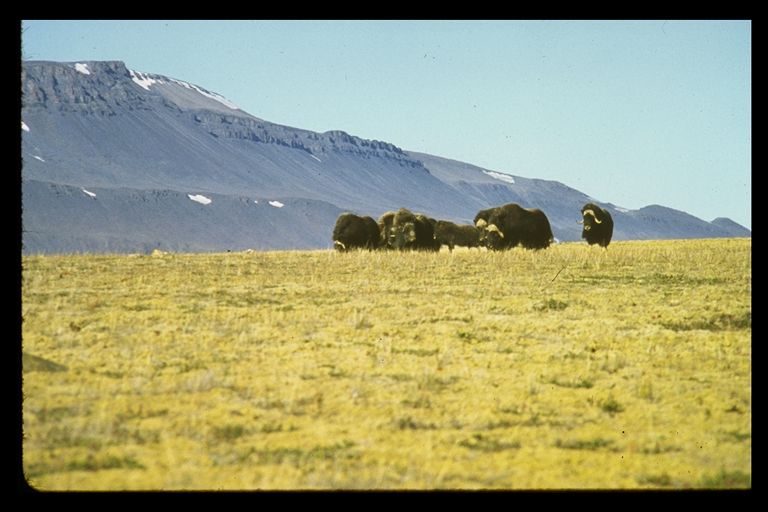Home page: www.treks.org
Table of Contents Arctic
Arctic Safari
Animal pictures (select):
Muskox Polar Bears White Cariboe White wolves Fox White HaresBirds Lemmings Arctic Char Beluga whales

Muskox herd, Eastern
Axel Heiberg Island.
The barren
Arctic North as scenic in wildlife as an African savanna wild park? It can
be, in the pristine wilderness of
Northern Canada.
Canadian Arctic Islands
The dry
Arctic dessert has no obstructing vegetation as the vegetation all stays close
to the ground. Small juniper shrubs [1] grow horizontally
and grass grows mainly in sheltered valleys. Also, the cold, dry and clean air
gives an excellent visibility.
You can
easily spot the bigger wild animals.
Most are white, which is a camouflage colour among the white snow patches which
cover the area for 11 months per year. Only muskox are black like their distant
cousins from the ice-ages, the yaks. A mature, healthy adult muskox does not need a camouflage as it is no match
for the only big game hunter, wolves. Polar bears only hunt for seals.
Most
visible are the bigger mammals, small herds of muskox, lonely old muskox bulls,
cariboes, alone or in small groups, foxes and numerous white hares. Wolves are
less common as they need a large territory.
While
camping for 5 summer seasons of two months each in many different locations on
Axel Heiberg and Ellesmere Island in the eighties, I saw a lot of wild animals,
even the extremely rare ones like the mythical white falcons, the so-called
'Gyr Falcons'.
The best
area for spotting animals is at Buchanan lake on Eastern Axel Heiberg Island,
see picture above, the bay of Mokka Fiord in the far distance (behind the salt
dome). The few km wide flood plain between the sea at Mokka Fiord and
inaccessible mountain ranges is the only North-South corridor on Axel Heiberg
Island in the summer when the sea straits have no solid ice.
Birds are
more common in the colder areas close to the Arctic Ocean like on Western Axel
Heiberg Island as their are less prey animals like foxes and wolves.
Epiloque
This area is rarely visited by tourist and given the fragile nature it better remain so. E.g.
a footstep in the muddy toundra will stay for tens of years. Moss and plants
may need a 100 years to come back.
A Twin
Otter plane could take you to the Lake Hazen National Park on Northern
Ellesmere Island. Russian ice breakers also do a trip from Resolute Bay to
Tanquary Fiord, South of lake Hazen,
through Eureka [1].
Prices are
high, count on $10000 for the boat and $15000 for the plane, for 2-3 weeks
only.
